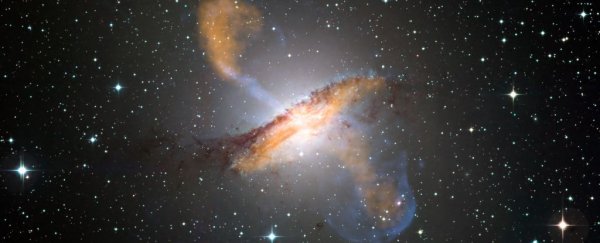Fluctuating light from a black hole, observed over 15 years, has revealed more about the way these enigmatic objects feed.
First, a structure called a corona forms around the outside of the event horizon. Then, powerful jets of plasma launch from the poles, punching material from the corona out into interstellar space at speeds close to that of light in a vacuum.
The finding – likened to the rhythmic pounding of a 'heartbeat' – resolves a long open question in black hole science.
"It sounds logical, but there has been a debate for twenty years about whether the corona and the jet were simply the same thing," explains astrophysicist Mariano Méndez of the University of Groningen in the Netherlands.
"Now we see that they arise one after the other and that the jet follows from the corona."
The black hole in question makes up part of GRS 1915+105, located about 36,000 light-years away from the Sun. It's what we call a microquasar – a stellar mass black hole locked in a close binary system with another object and feeding off it; in the case of GRS 1915+105, this is a normal star.
Because the two objects are so close together, the black hole strips material from the star; this material forms a disk around the black hole that gradually feeds into it.
It's the same thing we see on a larger scale in quasars, which are galactic nuclei that contain an active supermassive black hole millions to billions of times the mass of the Sun.
The black hole GRS 1915+105 is just 12 times the mass of the Sun, hence microquasar; even so, it's the one of the most massive stellar mass black holes known in the Milky Way.
This process generates a lot of light from the heating of the disk and the complicated environment around the black hole. One light-generating structure is the corona, between the inner edge of the accretion disk and the event horizon.
This is a region of scorchingly hot electrons thought to be powered by the black hole's magnetic field, acting like a synchrotron to accelerate the electrons to such high energies that they shine brightly in X-ray wavelengths.
Then there are jets. These are thought to consist of material accelerated along magnetic field lines outside the black hole's event horizon to the polar regions, where they are launched into space at speed, emitting light in radio wavelengths.
This is what scientists think, anyway. The space around black holes is so extreme that it's difficult to get a handle on the processes that take place.
Méndez and his colleagues wanted to learn more about how the jets are accelerated and launched. They collected X-ray and radio data on the microquasar collected between 1996 and 2012, and studied it carefully for clues.
Their final sample consisted of 410 simultaneous X-ray and radio observations of GRS 1915+105. This meant that they could observe changes in both kinds of light at the same time. They found that when X-ray light is strong, radio is weak, and vice versa; and that the jets are strongest when the corona is at its smallest.
This suggests that energy that powers the microquasar system can be directed either to the X-ray corona, or the relativistic jet. Added to models of the fluctuations in light from the system, the researchers concluded that, at least in GRS 1915+105, it seems that the corona turns into the jet.
"It was quite a challenge to demonstrate this sequential nature," Méndez said. "We had to compare data of years with that of seconds, and of very high energies with very low ones."
Next for the team will be to try and explain some oddities their observations revealed. The X-ray corona is brighter, they found, than can be accounted for by temperature alone. This means something else might be at play. The team thinks that the magnetic field could be responsible.
The differential rotation of the black hole and accretion disk can cause magnetic fields to become tangled and chaotic. When the magnetic field is chaotic, the team speculates, the corona heats up; when it snaps back into order, material can escape, and thus the jets are launched.
And this process should scale with black hole mass, too, which could help us understand the way massive quasars behave.
"In principle," the researchers write, "the same channeling of energy to the jet and the corona should happen in supermassive black holes, and should therefore apply to the full range of black hole masses in the fundamental plane of black hole activity."
The research has been published in Nature Astronomy.
